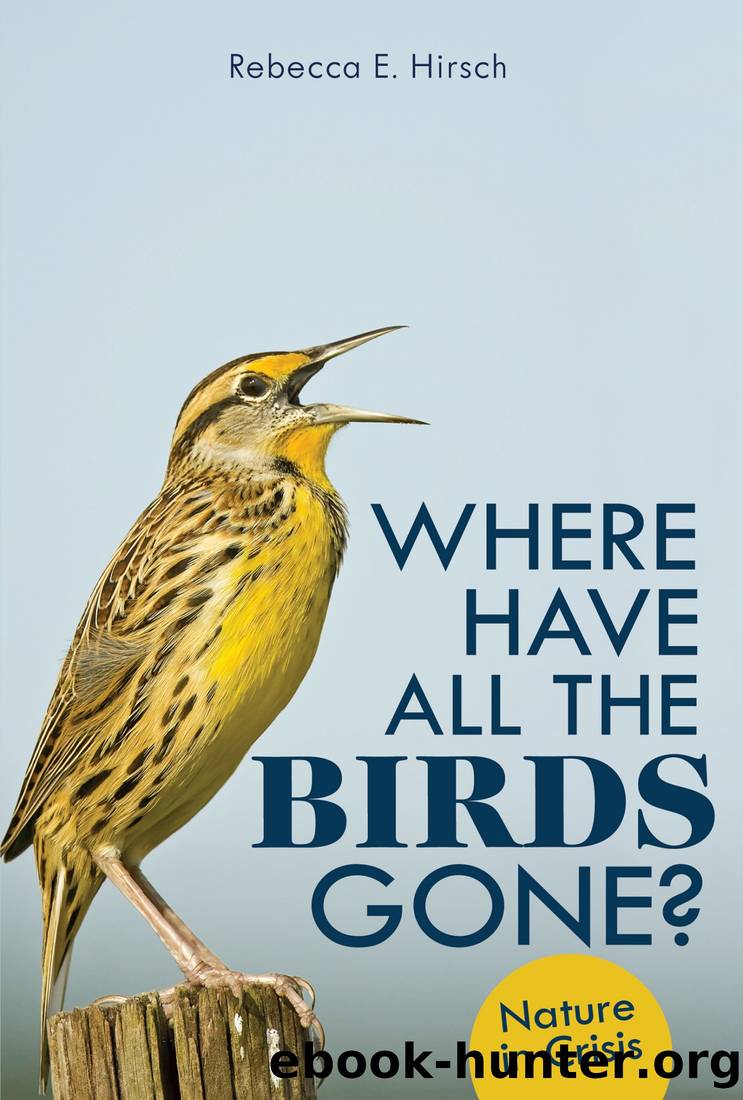Where Have All the Birds Gone?: Nature in Crisis by Rebecca E. Hirsch

Author:Rebecca E. Hirsch [Hirsch, Rebecca E.]
Language: eng
Format: epub
Tags: birds, dying birds, bird-friendly glass, bird populations, migration, city lights, climate change, pollution, deforestation, ecosystems, food systems, mental health, ecology, ornithology, conservation, native plants, building habitat, backyards, sustainable farming, bird sanctuaries, FLAP, Lights Out program, domestic cats, birds of prey, songbirds, raptors, seabirds, nature, Science, biology, environmental science, passenger pigeons, birdwatching, birders, bird feeders, flyway, bird count, pollinators, DDT, Silent Spring, windows, glass, pesticides, neonics, invasive species, monocropping, insect populations, agricultural intensification, agriculture, starvation, overhunting, mass extinction, Nonfiction, Young Adult Nonfiction, Young Adults
ISBN: 9781728455990
Publisher: Lerner
Published: 2022-03-02T00:00:00+00:00
The Late Bird
Researchers study white-crowned sparrows to see how neonicotinoids affect their health and behavior.
In spring 2017, Morriseyâs colleague Margaret Eng set up a mobile laboratory at Long Point Bird Observatory in Southern Ontario. The observatory sits on a narrow peninsula jutting out into Lake Erie and is home to a long-running bird-tracking program. The program traps migrating birds by snaring them in mist netsâfine-meshed nets that the birds canât see. Ornithologists and volunteers carefully untangle each trapped bird and wrap a lightweight metal band around its leg before releasing it to finish its migration. The band is stamped with a number and gives details on the species as well as the date and place of the birdâs capture. Bands allow observers to see which birds have been captured before and can help researchers keep track of birds as they migrate.
To help Eng with her project, bird banders at Long Point didnât release any white-crowned sparrows they caught in their mist nets. Instead, they handed the sparrows off to Eng. White-crowned sparrows have pale gray bodies and bold black-and-white stripes on their heads. They breed in brushy habitat in Canadian forests and stop in farmland during their spring migration, hopping on the ground in search of seeds. Eng wanted to learn what happens when birds such as these ingest small amounts of neonics.
Inside her mobile laboratory, Eng weighed each bird and then slipped it into a clear plastic tube. She inserted the tube into a dishwasher-sized quantitative magnetic resonance machine. The device scanned the sparrowâs body and measured the amount of water, lean mass (bone and muscle), and fat it contained. She then separated the sparrows into two groups. With one group, she used a syringe to feed each bird a tiny dose of neonics. A second group, the control group, received no pesticide.
Eng put the birds in cages. She gave them food and water, and they could eat and drink as much as they wanted. Six hours later, she again weighed each bird and scanned it in the quantitative magnetic resonance machine.
In that short span of time, she found that the pesticide-dosed birds lost on average of 6.5 percent of their body mass. Thatâs like a 130-pound (59 kg) teenager losing 8.5 pounds (3.9 kg) between lunch and dinner. Eng discovered that almost all the lost weight was from body fat, a birdâs main fuel for migrating. But the control birds didnât lose body mass or body fat.
Why had the birds lost weight after eating a bit of pesticide? By weighing the amount of food in the birdsâ cages, Eng discovered that the dosed birds had stopped eating. In people, nicotine suppresses appetite. Neonics were doing something similar to birds.
Eng wondered how this exposure would affect birds in the real world. After ensuring that each bird was âstill hopping around and happy,â she glued a tiny tracking device onto each birdâs back. The devices emitted radio pulses that could be picked up by a network of receiving stations.
Download
This site does not store any files on its server. We only index and link to content provided by other sites. Please contact the content providers to delete copyright contents if any and email us, we'll remove relevant links or contents immediately.
Pale Blue Dot by Carl Sagan(4887)
Cracking the GRE Premium Edition with 6 Practice Tests, 2015 (Graduate School Test Preparation) by Princeton Review(4207)
Pocahontas by Joseph Bruchac(4167)
Unfiltered by Lily Collins(3947)
The Emotionary: A Dictionary of Words That Don't Exist for Feelings That Do by Eden Sher(3302)
The Daily Stoic by Holiday Ryan & Hanselman Stephen(3215)
Factfulness_Ten Reasons We're Wrong About the World_and Why Things Are Better Than You Think by Hans Rosling(3187)
The President Has Been Shot!": The Assassination of John F. Kennedy by Swanson James L(3035)
The 48 laws of power by Robert Greene & Joost Elffers(2995)
Sapiens and Homo Deus by Yuval Noah Harari(2970)
Rogue Trader by Leeson Nick(2962)
The Innovators: How a Group of Hackers, Geniuses, and Geeks Created the Digital Revolution by Walter Isaacson(2785)
The Rape Of Nanking by Iris Chang(2764)
Gettysburg by Iain C. Martin(2720)
Almost Adulting by Arden Rose(2646)
The Plant Paradox by Dr. Steven R. Gundry M.D(2531)
500 Must-Know AP Microeconomics/Macroeconomics Questions(2520)
In the Woods by Tana French(2520)
Make by Mike Westerfield(2274)
